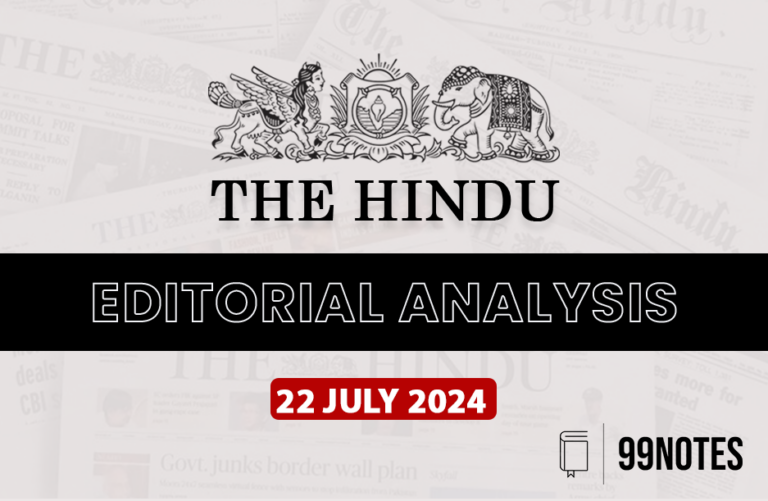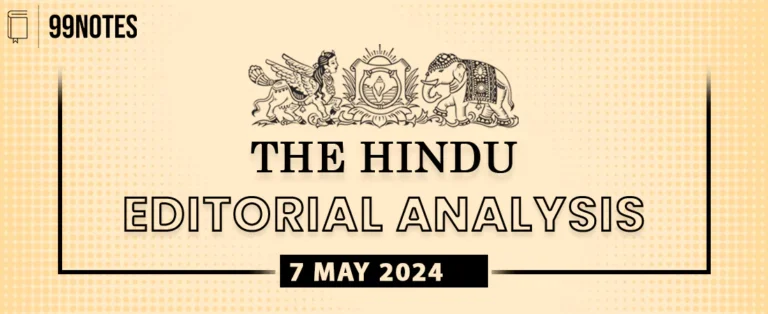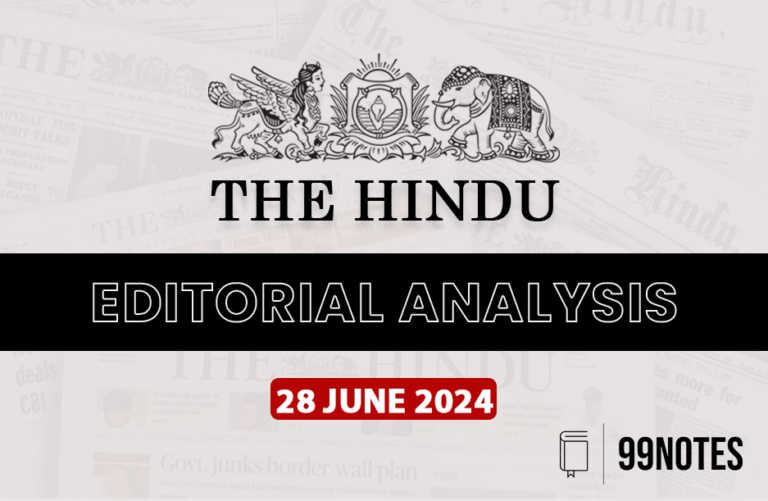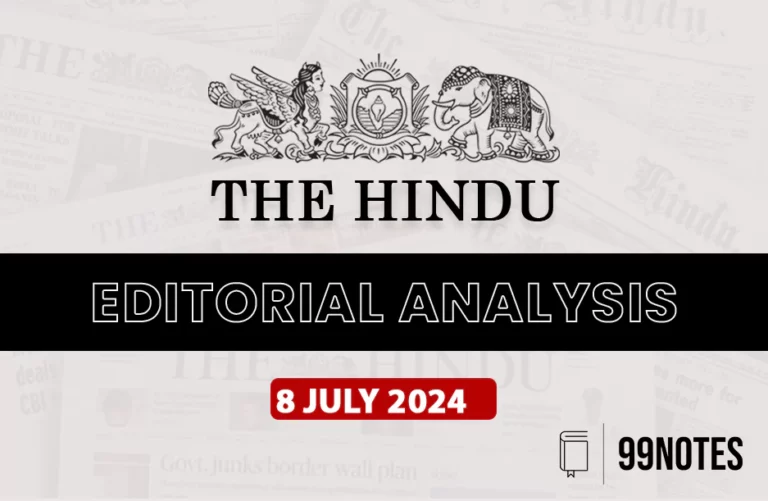27 November 2023 : The Hindu Editorial Notes PDF
The Hindu Editorial
27-November-2023
1. Old censorship on a new medium.
Topic: GS3 – Indian polity.
Uttarkashi Tunnel Collapse Incident:
- On November 12, 2023, an under-construction tunnel, part of the Char Dham all-weather road project in Uttarakhand, collapsed, trapping 41 workers.
- The Silkyara tunnel collapse, occurring about 30 km from the district headquarters, aimed to facilitate the pilgrimage journey to Uttarkashi’s Yamunotri shrine.
Media Coverage Dynamics:
- Initially reported on Deepavali, the collapse received detailed coverage in newspapers while television reports were limited.
- Television coverage increased as the rescue efforts progressed, transforming the narrative from negligence to a heroic rescue.
- Peak coverage occurred when the Chief Minister and Union Minister visited the site.
Media Landscape Challenges:
- The incident raised questions about environmental clearances and highlighted flaws in public works and civil contracting, directly impacting human lives.
- Television’s sparse coverage during the initial days was attributed to ideological partisanship, economic models, and a command-and-control media landscape.
Role of the Internet:
- TV remains the primary medium in approximately 165 million homes, but its growth is slowing.
- The government responds with the Broadcasting Services (Regulation) Bill, 2023, aiming to regulate online content and establish a censorship system.
Broadcasting Services (Regulation) Bill, 2023:
- Released on November 10, the bill aims to modernize and replace outdated laws, according to Union Minister Anurag Thakur.
- Similar to past legal proposals, it reflects a trend of increasing government powers, reduced transparency, and erosion of fundamental rights.
- The proposed bill retains and worsens existing powers, requiring registration and adherence to the program code for online broadcasters, journalists, and creators.
- It introduces a system of self-certification with public disclosure of committee members, granting vague and extensive powers to the Union government without anchoring criteria.
- The Broadcasting Advisory Council, comparable to the Inter-Ministerial Committee, remains government-bureaucrat dominated.
2. Fleet electrification to tackle urban pollution
Topic: GS3 – urban pollution
Air Quality Challenges:
- The air quality index (AQI) in many Indian cities frequently enters the red zone, posing serious health hazards.
- Mitigation strategies need prioritization to address recurring increases in air pollution.
Contributors to Urban Smog:
- Studies like the Urban Emission (2015) and the TERI study (2018) highlight PM2.5 and PM10 pollution from the transport and construction sector as significant contributors to urban smog.
Truck Fleet Impact:
- Approximately 9 lakh new trucks are added to Indian roads annually, contributing to a total fleet of 70 lakh trucks.
- Trucks are responsible for over 90% of road transport CO2 emissions and consume one-fourth of Indian oil imports.
Challenges in Truck Electrification:
- India’s electric vehicle penetration rate has surpassed 6%, but electric trucks face challenges due to upfront costs and charging infrastructure limitations.
- Electrification efforts primarily focus on buses, necessitating a broader approach to include diesel trucks and dust mitigation.
Need for Urgent Solutions:
- Swift deployment of solutions is crucial to address the urgency of air quality concerns, especially in the context of PM2.5 pollution.
- The recent demand for 7,750 e-trucks by 2030 could save over 800 billion liters of diesel by 2050, emphasizing the potential impact of electrification.
Transition Challenges:
- Despite the success in electrifying three-wheelers, truck electrification faces hurdles such as the higher upfront cost of mid-range electric trucks (₹5 crore compared to ₹40 lakh for diesel trucks).
- Cost of charging logistics remains a significant obstacle in the widespread adoption of e-trucks in India.
Green Freight Corridors:
- Designating expressways and national highways as green freight corridors could have a demonstrative effect on the country.
- Accelerating feasibility studies, demand aggregation, supplier readiness, and a prudent risk allocation strategy are essential for creating green freight corridors.
Financial Considerations:
- Public funding alone is insufficient for the scale required; there is a need for effectively structured, bankable projects to attract private and institutional capital.
- A concerted effort is necessary to overcome challenges, including innovative financial instruments, incentivization of charging infrastructure, and a conducive regulatory environment.
Urgency for Concerted Efforts:
- Recognizing the urgency, concerted efforts are needed to create breakthroughs in truck electrification in India.
- Green freight corridors, facilitated by financial instruments and a supportive regulatory environment, can play a crucial role in achieving this goal.
Question: How can India address the dual challenge of mitigating air pollution, particularly PM2.5 pollution from the transport and construction sectors, and accelerating the electrification of its truck fleet to reduce CO2 emissions.
3. Moulding the Himalayas needs caution
Topic: GS3 – development and ecological damages.
Infrastructure Development Challenges in Indian Himalayas:
- Ongoing efforts to evacuate trapped workers in a Uttarakhand tunnel highlight concerns about the sustainability of Himalayan infrastructure development.
- Questions raised about the viability of the current model involving road expansion, hydropower projects, and tourism promotion.
Issues with the Char Dham Project:
- The Char Dham Project by the National Highway Authority of India (NHAI) links religious pilgrimages in Uttarakhand.
- Concerns include the development model’s suitability, environmental clearance processes compromising safety protocols, and the need for a new architecture for monitoring infrastructure projects.
- The construction of Char Dham Yatra, initiated after the 2013 flash floods in Uttarakhand, is seen as using a tragedy as a basis for development.
Geological Challenges:
- The Himalayas being a young and geologically active mountain range poses risks for construction projects.
- The presence of frictional shear rocks and sensitivity to earthquakes makes the construction in such zones dangerous.
Lack of Adherence to Construction Codes:
- Frenzied construction activity in the region overlooks basic mountain construction codes.
- Lack of seriousness in implementing Environment Impact Assessments (EIAs) is evident, with projects being fragmented to reduce the impact exhibited in EIA reports.
Need for Dialogue on Carrying Capacity:
- The Supreme Court’s intervention on carrying capacity in the Himalayas prompts the need for a comprehensive dialogue.
- Carrying capacity must consider infrastructure aspects, addressing questions about the sustainable number of hydropower projects, tourism, roads, and road widening.
Transformative Phase and Irreparable Tragedies:
- The Indian Himalayan Region (IHR) faces irreparable tragedies due to transformative changes influenced by new geographies.
- Integrating the IHR with broader development plans without considering local ecological, cultural, and architectural aspects is unsustainable.
Safety Protocols and Legislative Architecture:
- Exceptional safety measures in the construction of the Atal tunnel in Himachal Pradesh emphasize the importance of stringent safety protocols.
- Adoption of international protocols, legislative frameworks allowing public monitoring, and involvement of geological experts is essential for safe infrastructure development.
- Local communities, civil society groups, and community-driven organizations should play a crucial role in monitoring and ensuring safety standards.
NHAI’s Responsiveness:
- NHAI’s belated recognition of the need for safety measures indicates bureaucratic callousness and a habitual disregard for monumental issues.
- Emphasis on meeting targets without ensuring stability and safety standards exacerbates disaster proneness.
Lesson from Successful Protocols:
- The Border Roads Organization (BRO) and the Pradhan Mantri Gram Sadak Yojana (PMGSY) showcase better construction protocols, allowing for stability periods before project completion.
- NHAI should learn from these examples to prevent future disasters in Himalayan construction projects.
For Enquiry

27 November 2023 : The Hindu Editorial Notes PDF

25 Nov 2023 : Daily Quiz

25 Nov 2023 : Daily Answer Writing

25 Nov 2023 : Indian Express

25 Nov 2023 : PIB

25 November 2023 : Daily Current Affairs

25 November 2023 : The Hindu Editorial Notes PDF

24 Nov 2023 : Daily Quiz

24 Nov 2023 : Daily Answer Writing

24 Nov 2023 : Indian Express
November 2023 The Hindu 27 November 2023 : The Hindu Editorial Notes PDF The Hindu Editorial
25-November-2023
1. Need for climate-smart agriculture in India
Topic: GS3 –…
Daily Quiz 25 Nov 2023 : Daily Quiz 25 Nov 2023 : Daily Quiz…
mains answer writing 25 Nov 2023 : Daily Answer Writing Mains Answer Writing
25-November-2023
1. How do you explain the decline of Buddhism and Jainism? What…
Indian Express 25 Nov 2023 : Indian Express Indian Express
25-November-2023
1) CURBING EXUBERANCE
Context:
As stated in the Reserve Bank of India’s…
November 2023 PIB 25 Nov 2023 : PIB PRESS INFORMATION BUREAU
25-November -2023
1. INDIA- NEPAL JOINT MILITARY EXERCISE SURYA KIRAN- XVII…
Daily Current Affairs 25 November 2023 : Daily Current Affairs Daily Current Affairs
25-November-2023
1. Afghanistan Embassy in Delhi shuts down
Topic: GS2 –…
November 2023 The Hindu 25 November 2023 : The Hindu Editorial Notes PDF The Hindu Editorial
25-November-2023
1. Need for climate-smart agriculture in India
Topic: GS3 –…
Daily Quiz 24 Nov 2023 : Daily Quiz 24 Nov 2023 : Daily Quiz…
mains answer writing 24 Nov 2023 : Daily Answer Writing Mains Answer Writing
24-November-2023
Q1) How does the Archeological evidence help in piecing together…
Indian Express 24 Nov 2023 : Indian Express Indian Express
24-November-2023
1) Engaging With APEC
Context:
After a 12-year hiatus, the US hosted…





